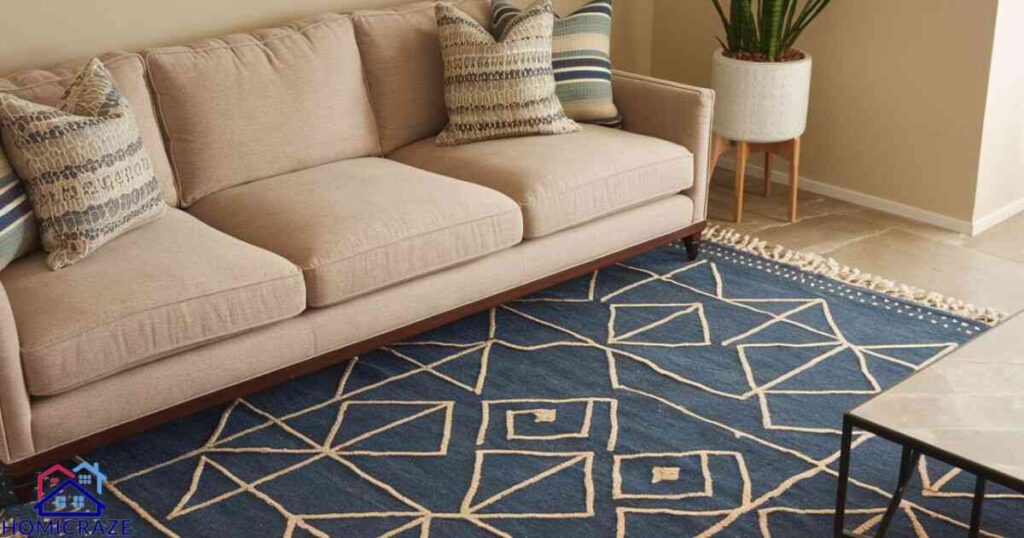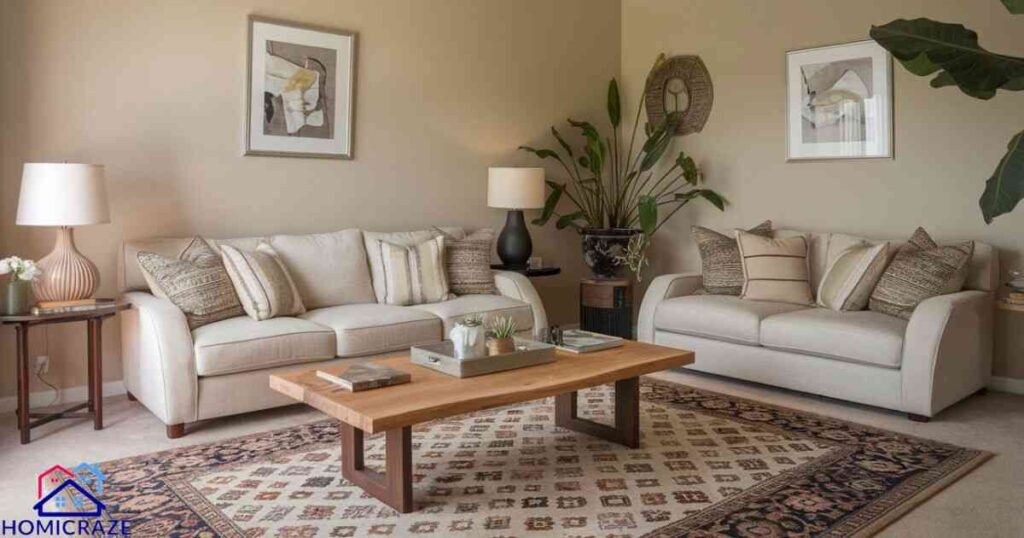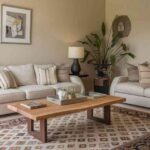Selecting the right rug for your sofa is one of the most challenging aspects of interior design. Many homeowners struggle with mismatched colors, conflicting patterns, and improper sizing that make their living spaces feel disjointed and unfinished.
These design missteps can turn what should be a welcoming room into an awkward space that never feels quite right. This comprehensive guide will walk you through the essential principles of sofa and rug pairing, from size and placement to color coordination and style matching.
With our expert tips and practical approaches, you’ll learn how to create a cohesive, professional-looking living room that perfectly balances your sofa and rug choices.
Basics of Sofa and Rug Coordination

The art of coordinating sofas and rugs forms the cornerstone of successful living room design. These two elements work together to define your space and set the foundation for all other decor choices.
The Foundation of Room Design
Your sofa and rug serve as the primary anchors in your living room. The sofa typically represents the largest furniture investment, while the rug creates the visual foundation that ties everything together.
A well-chosen pair establishes clear boundaries within your space and guides the eye naturally through the room. Professional designers start their room planning with these two pieces because they determine the scale, color palette, and overall style direction of the space.
The Role of Room Size
Room dimensions directly impact your sofa and rug choices. For optimal flow and balance, your room’s square footage determines the maximum size of both pieces. A general rule states that you should maintain at least 18 inches of bare floor space around the edges of your rug. In rooms with high ceilings (9 feet or taller), larger rugs help balance the vertical space and prevent the room from feeling bottom-heavy.
Table: Quick Room Size Guide for Rug Selection
| Room Size (sq ft) | Recommended Rug Size |
| Under 200 | 5′ x 8′ |
| 200-300 | 8′ x 10′ |
| Over 300 | 9′ x 12′ or larger |
Size and Placement Guidelines
Determining the Perfect Rug Size
Standard rug sizes follow specific rules based on your sofa’s dimensions. For a three-seat sofa, select a rug at least 8 feet wide. This ensures proper proportions and prevents the furniture from appearing to float. Measure your seating area and add 24-30 inches on all sides to find your ideal rug size. This extra space creates a balanced look and defines the conversation area.
Strategic Placement Rules
The front legs of your sofa should rest on the rug by at least 6-8 inches. This creates visual unity and prevents tripping hazards. For open-concept spaces, use the rug to define separate areas by positioning all furniture legs either completely on or off the rug. Contemporary designs often feature asymmetrical placement, with the rug extending farther on one side than the other.
Room-Specific Considerations
Large rooms benefit from layered rugs or multiple seating areas, each anchored by its own rug. In spaces over 400 square feet, consider using two coordinating rugs to create distinct zones. Small rooms require more strategic planning – opt for a rug size that allows for at least 12 inches of visible floor space around the perimeter. This prevents the space from feeling cramped while maintaining proper proportions between your sofa and rug.
These fundamental guidelines create the framework for successful sofa and rug pairing. Understanding these basics helps you make informed decisions about size, placement, and room-specific adaptations. With this foundation, you can move forward to explore color coordination and style elements with confidence.
Pattern and Texture Dynamics
The interplay of patterns and textures creates depth and visual interest in your living space. Understanding how to combine these elements effectively transforms your room from flat to dynamic.
Pattern Mixing Principles
Successful pattern mixing relies on varying scales. Pair a large-scale pattern on your sofa with a medium or small-scale pattern on your rug. A floral sofa works well with a geometric rug when the patterns share at least one color. The 60-30-10 rule guides pattern distribution: 60% dominant pattern, 30% secondary pattern, and 10% accent pattern.
Texture Combinations
Texture adds dimension without overwhelming the space. A smooth leather sofa pairs beautifully with a high-pile or shag rug. Velvet upholstery complements flat-weave rugs with subtle texture variations. Layer different textures to create depth – combine a sisal base rug with a plush accent rug for maximum impact.
Table: Texture Pairing Guide
| Sofa Material | Ideal Rug Texture |
| Leather | High-pile/Shag |
| Velvet | Flat-weave |
| Linen | Berber/Loop-pile |
| Microfiber | Cut-pile |
Style-Specific Pairing Guide
Contemporary and Modern
Modern design emphasizes clean lines and minimal patterns. Choose geometric rugs with subtle patterns for contemporary sofas. Mid-century modern sofas pair well with solid-colored rugs featuring interesting textures. The focus remains on form and function rather than ornate details.
Traditional and Transitional
Traditional pairings often include classic Persian or Oriental rugs with rolled-arm sofas. Transitional styles bridge the gap between classic and contemporary. Mix a traditional-patterned rug with a modern sofa, or pair a classic sofa with a contemporary geometric rug.
Read This Blog: What Is a Florida Room? A Complete Homeowner’s Guide for 2024
Modular and Sectional Solutions
Modular furniture requires flexible rug solutions. Select oversized rugs that accommodate all configurations of your sectional. For L-shaped sectionals, rectangular rugs should extend beyond both sides. Consider round rugs for modular arrangements that change frequently.
Practical Considerations
Budget Planning
Quality rugs represent a significant investment. Allocate 20-30% of your furniture budget for a well-made rug. High-traffic areas benefit from durable materials like wool or polypropylene. Save money by choosing synthetic materials that mimic natural fibers.
Maintenance and Durability
Different materials require specific care routines. Natural fibers like wool need professional cleaning yearly. Synthetic rugs offer easier maintenance with regular vacuuming and spot cleaning. Consider furniture leg protectors to prevent rug damage from heavy sofas.
Trending Combinations for 2024
Current Style Movements
The 2024 trend forecast highlights sustainable materials and bold geometrics. Vintage-inspired rugs paired with modern sofas continue to gain popularity. Earth tones and organic patterns reflect growing environmental consciousness in interior design.
Also Read This Blog: Wood Dining Room Table: Classic Elegance for Your Home
Designer Insights
Professional designers recommend investing in timeless pieces while experimenting with trendy accessories. Layer rugs to create visual interest and flexibility. Mix patterns within the same color family for a cohesive look. Leading designers emphasize the importance of proportion over perfect matching.
Include regular maintenance in your design plan to protect your investment. Quality materials and proper care ensure your sofa and rug pairing remains beautiful for years to come.
Common Pairing Mistakes to Avoid
Interior design success often depends on avoiding common errors. Understanding these pitfalls helps create more successful room designs.
Size and Scale Errors
The most frequent mistake in sofa and rug pairing is choosing an undersized rug. Small rugs make rooms feel disconnected and cramped. A rug should extend at least 6-8 inches beyond your sofa’s edges. Avoid “floating” furniture by ensuring all major pieces connect with the rug. Scale problems occur when the rug’s pattern size doesn’t complement your sofa’s proportions.
Style Mismatches
Style conflicts arise when mixing incompatible design elements. Modern sofas clash with traditional Oriental rugs unless carefully balanced. Busy patterns fighting for attention create visual chaos. Maintain harmony by coordinating colors, patterns, and textures within your chosen design style.
Frequently Asked Question
Do you put a rug under a sofa?
Yes, place the front legs of your sofa on the rug. This creates visual unity and defines the seating area.
Why is it called rug?
The term “rug” comes from Old Norse “rogg,” meaning shaggy wool or tuft, referring to its woven textile nature.
Why is it called a sofa?
Sofa” derives from the Arabic word “suffah,” meaning bench or long seat with cushions.
How to pair sofa and rug?
Match colors, patterns, and styles while ensuring proper size proportions and placement for a cohesive look.
What size rug for living room?
Choose a rug size that extends 18-24 inches beyond your furniture grouping on all sides.
Should I add a rug to my room?
Yes, rugs add warmth, define spaces, and protect floors while enhancing your room’s overall design.
Conclusion
Creating the perfect sofa and rug combination transforms your living space into a harmonious sanctuary. Focus on proper sizing, coordinated styles, and balanced patterns while avoiding common mistakes. Your carefully chosen pairing will create a foundation for lasting comfort and timeless design.







